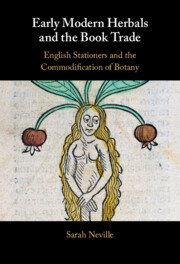
Author: Sarah Neville (Ohio State University)
Publisher: Cambridge University Press, 2021 – Available in Open Access
Between 1525 and 1640, a remarkable phenomenon occurred in the world of print: England saw the production of more than two dozen editions identified by their imprints or by contemporaries as ‘herbals’. Sarah Neville explains how this genre grew from a series of tiny anonymous octavos to authoritative folio tomes with thousands of woodcuts, and how these curious works quickly became valuable commodities within a competitive print marketplace.
Designed to serve readers across the social spectrum, these rich material artifacts represented both a profitable investment for publishers and an opportunity for authors to establish their credibility as botanists. Highlighting the shifting contingencies and regulations surrounding herbals and English printing during the sixteenth and early seventeenth century, the book argues that the construction of scientific authority in Renaissance England was inextricably tied up with the circumstances governing print.
Contents
List of Figures
Acknowledgments
Note on Transcription and Citation
List of Abbreviations
Prologue: Milton’s Trees
Introduction: Authorizing English Botany
1 Authorship, Book History, and the Effects of Artifacts
2 The Stationers’ Company and Constraints on English Printing
3 Salubrious Illustration and the Economics of English Herbals
4 Reframing Competition: The Curious Case of the Little Herball
5 The Grete Herball and Evidence in the Margins
6 “Unpublished Virtues of the Earth”: Books of Healing on the English Renaissance Stage
7 William Turner and the Medical Book Trade
8 John Norton and the Redemption of John Gerard
Bibliography
Index